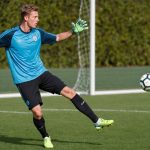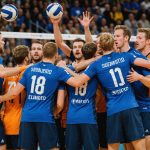Importance of Reflexes in Goalkeeping
In the demanding world of soccer, the importance of reflexes for a goalkeeper cannot be overstated. Reflexes are the swift reactions that allow a keeper to respond to unexpected shots, making the difference between a win or a loss. The faster a goalkeeper’s reflexes, the better their chance of saving the ball before it reaches the net. This is a core element of essential goalkeeper skills and a critical focus in professional soccer training.
Improved reflexes have a profound impact on game outcomes. A goalkeeper with sharp reflexes can anticipate and intercept the ball more effectively, leading to more successful saves and preventing goals. This capability not only boosts the goalkeeper’s confidence but also enhances the team’s overall performance and morale. Reflex training is, therefore, an integral part of soccer training programs to ensure goalkeepers perform at their best under pressure.
Also to see : Discover unique snowshoe outings in avoriaz this winter
Furthermore, there is a significant connection between reflexes and overall athleticism. Quick reflexes are the result of well-coordinated muscle activity, keen focus, and mental alertness. These attributes contribute to a goalkeeper’s agility, speed, and balance—vital components of a soccer player’s athletic prowess. Thus, honing reflex skills is crucial for goalkeepers aiming to excel in their roles.
Understanding Reaction Time
Reaction time is critical in sports, especially for goalkeepers who must respond to fast-paced scenarios. It refers to the time it takes for the brain to process information, make a decision, and execute a response. For goalkeepers, quick reaction time is essential for efficient coordination on the field.
Have you seen this : Elevating team handball success: essential communication tactics for athletes
Several factors can influence a goalkeeper’s reaction time. These can include cognitive processing abilities, physical fitness levels, and environmental conditions. For instance, the speed of incoming play and visual clarity are significant contributors to how quickly a goalkeeper can react.
Enhancing cognitive processing speed is vital to improving reaction time. Goalkeepers can employ various training techniques, such as:
- Neurocognitive drills: Exercises designed to improve mental agility and reaction.
- Simulation training: Virtual scenarios that mimic real sporting events to test and enhance reaction capabilities.
- Focus enhancement: Methods to improve attention and minimize distractions during play.
These techniques have shown to be effective in enhancing a goalkeeper’s reaction time by fine-tuning their cognitive processing. By anticipating and recognizing plays quicker, goalkeepers can respond more effectively, potentially altering the outcome of a game. Understanding and improving reaction time not only boosts performance but also builds a goalkeeper’s confidence on the field.
Recommended Drills for Goalkeeper Reflex Training
Training a goalkeeper requires dedication, precision, and effective goalkeeper drills. These drills are crucial for honing reflexes and ensuring top performance during matches. Let’s explore some practical solutions.
Drill 1: Quick Reaction Saves
This drill is a staple in reflex training. The equipment needed includes a set of cones and a soccer ball. Set up the cones in a zigzag pattern, and have an assistant randomly roll or throw balls towards the goal. The goalkeeper must quickly move through the cones, reacting to each ball to make the save. This exercise improves hand-eye coordination and agility, essential components of soccer practice.
Drill 2: Ball Toss Against Wall
Another simple yet effective method is the ball toss against a wall. With a soccer ball, the goalkeeper stands a few feet from a wall and throws the ball at various angles, catching it on the rebound. This helps develop quick reflexes and strengthens hand-eye coordination.
Drill 3: Partner Shot Practice
Partner shot practice involves a partner who takes rapid shots at the goalkeeper. No special equipment is needed, just a soccer ball. This drill sharpens reaction time and builds confidence in handling unpredictable ball trajectories. Each of these drills enhances vital skills for successful goalkeeping.
Expert Tips for Maximizing Training Effectiveness
Focusing on training optimization is crucial for any goalkeeper aiming to improve their game. To start, maintaining focus during drills cannot be overstated. It’s essential to approach each practice session with a clear mind and precise objectives, ensuring you extract the most value from your efforts.
A common pitfall many fall into is repeating the same routines without considering their effectiveness. This is where professional advice becomes invaluable. Engaging with coaches and mentors who can provide feedback can prevent stagnation and promote growth.
Another aspect to consider is the integration of variability in goalkeeper techniques. Introducing a mix of different skill sets can enhance adaptability in different match scenarios. For instance, including exercises that simulate unexpected game situations prepares goalkeepers for real match dynamics, enhancing reaction times and decision-making skills.
Avoiding common mistakes, such as neglecting rest and recovery, is equally important. Overtraining without adequate rest can lead to burnout and injuries, hindering progress. Practising mindfulness and relaxation techniques can help in maintaining a balanced training schedule.
Remember, the key is consistency paired with strategic variation. With focused practice and expert guidance, goalkeepers can optimize their training and achieve desired outcomes effectively.
Video Demonstrations and Tutorials
To master goalkeeper techniques, visual aids such as video training can be invaluable. Watching these resources enables you to see proper movement and form in real-time. High-quality training resources provide drills with instructional videos, making learning more accessible. They illustrate the nuances of goalkeeper techniques, helping you grasp complex maneuvers with ease.
Visual Representation of Proper Techniques
Engaging with video training offers a clear view of what excellence looks like. By observing professional goalkeepers, you can mimic their stances and reactions. These videos break down each technique into manageable steps, allowing you to follow along and replicate core skills like diving saves and angle positioning.
How to Self-Assess Progress
Monitoring your development is key to becoming a skilled goalkeeper. Consider recording your practice sessions; this enables you to apply video review strategies to identify strengths and weaknesses. Compare your performance to the training resources, adjusting where needed. Frequent reviews help in refining your techniques and maintaining steady progress.
Avail yourself of these valuable training resources, and you’re well on your way to honing your skills. The combination of observation and self-assessment through videos ensures a comprehensive understanding and growth in your goalkeeping journey.
Tracking Improvement Over Time
To enhance goalkeeper assessment, it is essential to set precise and measurable goals for reaction time improvements. This objective measurement aids in defining the gap between current and desired performance. Use specific performance metrics to establish these goals, such as the number of saves per match or response time to a variety of shots.
Incorporating tools and methods for assessing reflex performance is crucial for effective progress tracking. Advanced technology, such as reaction timers and video analysis software, provides accurate data on a goalkeeper’s response times, helping in identifying areas needing improvement. Regular testing with these tools will offer insights into how a goalkeeper’s reflexes are developing over time.
The importance of consistent practice cannot be overstated. Engaging in drills that simulate real match conditions ensures that the skills required for swift and effective decision-making are continually honed. This habitual training, combined with regular progress evaluations using performance metrics, enables goalkeepers to fine-tune their abilities.
Monitoring progress through these practices and tools empowers goalkeeper assessment to be more effective and insightful, leading to substantive improvements in performance. Observing trends over time not only motivates players but also provides tangible evidence of their development, guiding future training decisions.











